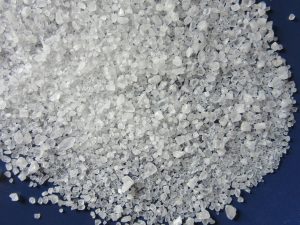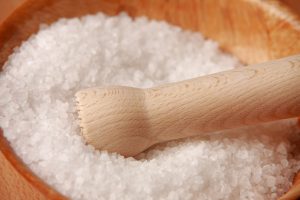What exactly is Kosher salt?
Kosher salt is really a misnomer: it should be called koshering salt. This is salt that was used to ‘kasher’ chicken and beef, by removing the blood from the flesh.
Remember the familiar red and yellow box of kosher salt in Bubby’s pantry? While its use in kosher processing has moved out of the kitchen, it’s still very much in use—as a gourmet staple.
Back from a walk to the community butcher, freshly-slaughtered chicken or rib roast in tow, Bubby would reach for a special pail, to be filled with cold water, wherein the meat was soaked for a half-hour. Still wet, it was set on a perforated board so that the blood could drip through. And then—like fallen snow, koshering salt was sprinkled liberally over the meat, covering every crack, crevice, and cavity therein. After remaining thus in state for an hour, the meat was rinsed three times, removing both salt and surface blood.
But soaking and salting at home are a thing of the past—for the new age of meat purveyors, whose army of soakers and salters at the factory level have stripped Bubby of her job.
In cooking terms, this salting process is called dry–brining. It has its culinary advantages, as it is said to be marinating the meat in its own juices. In fact, dry-brining is said to improve a bird’s ability to retain moisture, as salt helps break down muscle fibers, seasoning the bird throughout.
Indeed, kosher salt has become a handy go-to item on any chef’s countertop, with a small container at the ready, to be sprinkled, with a flick of the culinary wrist, into cooked foods.
This may be due to kosher salt’s many advantages.
One advantage is its purity. Salt tends to cake up, at high humidity — remember the grains of rice in summer-camp salt shakers? To counter this, standard table salts may contain various additives, called ‘free-flowing agents’ and ‘anti-caking agents.’ These might include sodium aluminosilicate, or magnesium carbonate. And who hasn’t looked askance at the labeled mention of ‘yellow prussiate of soda?’ Where is Prussia, anyway? Also added is iodine, used to prevent maladies stemming from a lack of that nutrient. But sodium iodide just doesn’t enhance the flavor of a roast. For better or worse, kosher salt has none of these additives—leaving no pungent or bitter aftertaste.
Kosher salt has a flaky texture that is prized by chefs. And it is easy to use: Estimating the amount of salt needed by hand is a snap, due to its large grain size. Kosher salt flakes dissolve easily in soups and stews. Strewn on meat, it lends a light crunch as the fabled ‘salt crust.’
But be advised: a teaspoon of kosher salt is less salty than its smaller-grained table-salt counterpart. In fact, there is a long-running discussion about the respective culinary qualities of Diamond Crystal vs. Morton Salts. Chefs say that Morton Salt is thinner, with coarser, denser roller-pressed flakes, and are almost twice as salty as Diamond Crystal’s light, hollow pyramid-shaped flakes. Morton Salt takes longer to dissolve, they say. Both products are OU Kosher certified and taste great.
Beyond kosher salt, some other salt trends (many of which are available with the OU kosher symbol) are as follows.
Like fine wine, ‘fleur de sel’ salt is made in various areas of the Guerande region of France, out of ‘young’ salt crystals that form naturally on the surface of salt evaporation ponds. Critics say each region has a different flavor profile. ‘Sel gris,’ or grey salt, is fresh from the Atlantic cost of that country; Hawaiian sea salt is red or black, with the presence of local volcanic minerals, for an earthy taste. Smoked sea salt is processed over wood fires, for a smokehouse effect. And Himalayan salt, culled from the ‘Salt Range Mountains’ south of the Himalayas, gets its familiar pink color the minerals there, with alleged health benefits—and proven garnish benefits. 
But kosher salt stands proudly among her cousins in the gourmet kitchen pantry. We Jews can take pride that the world has come to appreciate the benefits of our kosher salt—even if used in ways Bubby would have never imagined.
(SIDEBAR)
What is salt exactly, how is it processed—and why does it taste so good?
Salt is composed of exactly two ions: sodium, and chloride. You’ll find in abundance all around you—in seawater, which consists of about 2.5 percent salt, along with some other minerals. Evaporating seawater is a time-honored method of obtaining salt, as seawater is moved through a series of evaporating ponds. The various minerals in seawater precipitate form the water at different rates. This process requires a nice, hot climate, such as that of the Dead Sea.
Alternately, salt can be found on safer shores, mined from the rich salt deposits in the earth. Huge chunks of salt are mined in underground caverns, leaving behind ceiling-high pillars of salt. (Lot’s wife, look out!) These maintain the structure of the mine and are left in place, for further mining.
In other operations, a well is dug into the ground and fresh water is pumped thereto. The water dissolves the salt to form brine, which is then pumped to the surface, to be dried via a device called the vacuum pan. Then the mineral is sorted for quality, and summarily crushed, ground and screened. High-quality salt ground into fine particles is your table salt. Pass the salt, please.
All of this is good news for that marvel of creation, the mighty and discerning human tongue. ‘Salt’ is one of the four (now five) primary tastes that we have—the others are bitter, sweet, sour, and “umami,” a relatively recent arrival on these shores. Umami is the savory taste you’ll find in MSG, which has lured many of our co-religionists away from the corner deli (read: salt; bitter; sweet,) and into the pungent ‘umami’ aisles of the (kosher) Chinese restaurant.
Stripped of any other biological activity, salt is simply a primary taste that the human tongue can detect. Yet salt also diffuses the molecules of the foods not the air, wafting the aroma of the food, enhancing our perception of its taste.


